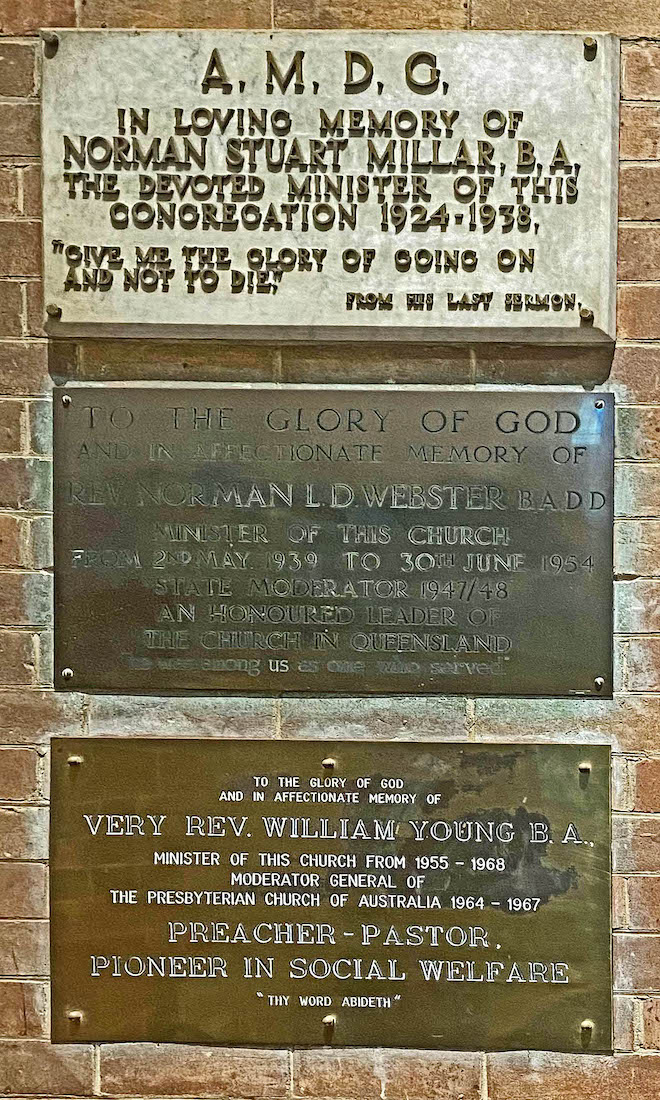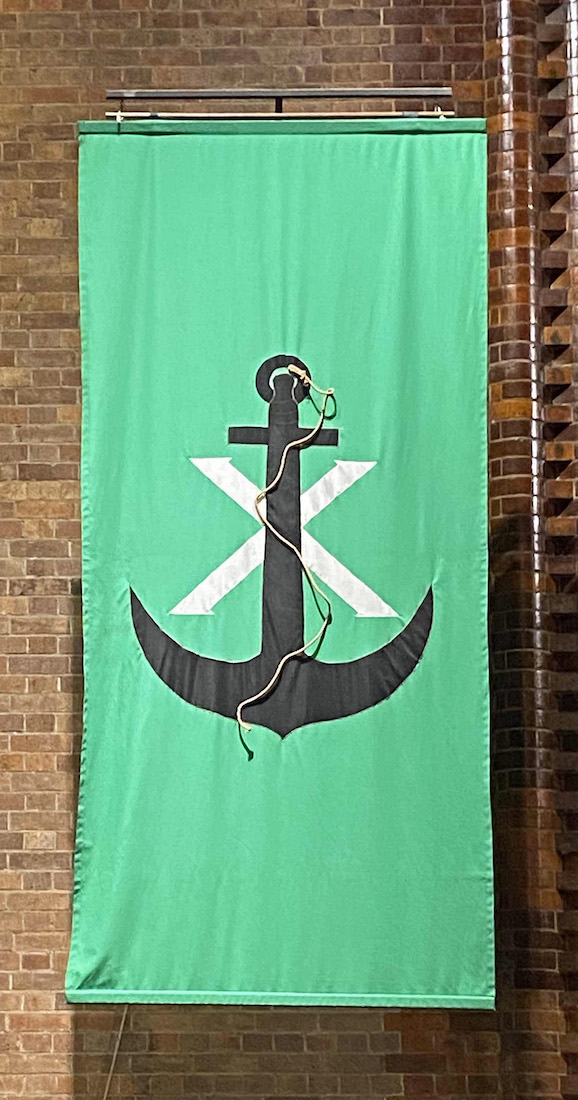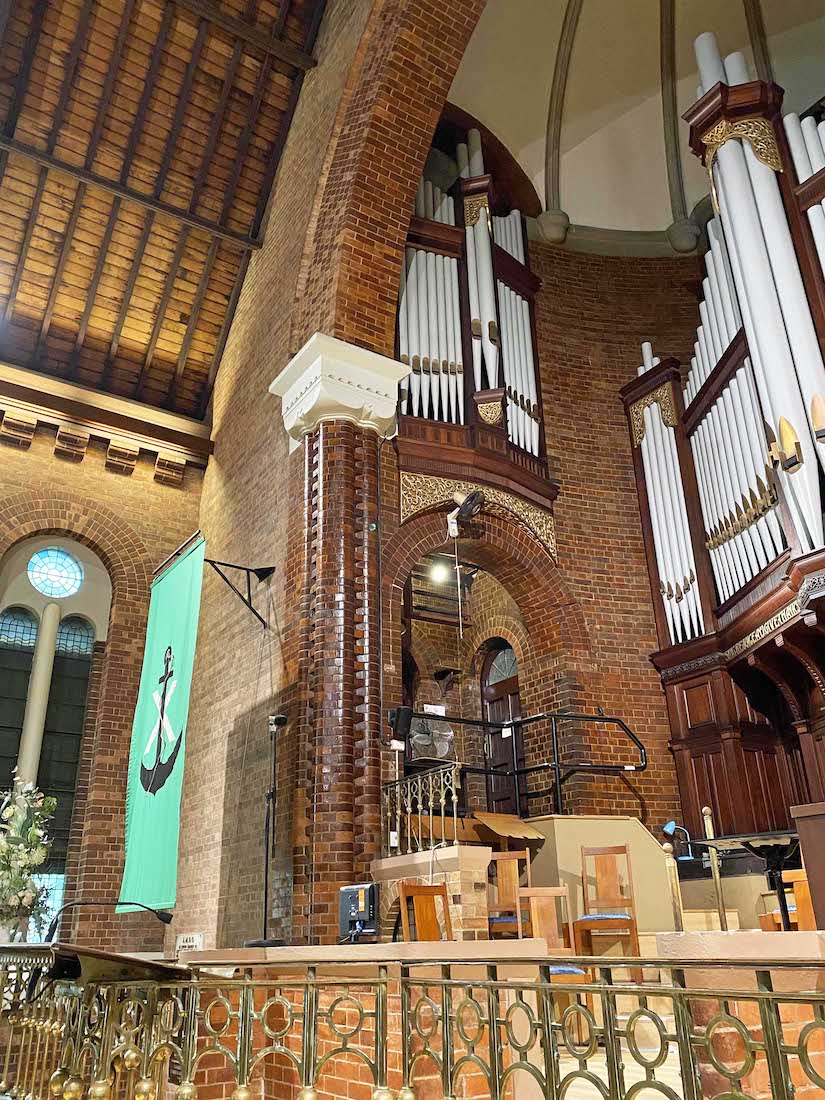

To the left of the display cabinet is this photograph of a painting by Graham Ashton of St Andrews Church. It was commissioned as a gift to the Bali Protestant Church in 1984. ••• To the right of the display case and on the facing wall are three plaques. These remember three past ministers of this Church: Norman Stuart Millar (1924 – 1938), Norman L.D. Webster (1939 – 1954), and William Young (1955 – 1968). INDEX
42. CARVINGS


It appears that St Andrew’s has some sort of partnership with the Bali Protestant Church. This is celebrated in this cabinet of Bali carvings and artefacts.
43. SANCTUARY NORTH ARCHWAY
What an enticing archway! Upstairs, downstairs, or around on the level following the curve of the apse.
44. SANCTUARY SOUTH AISLE
There is a similar short aisle on the South side of the sanctuary, again leading to an archway, but here also leading on the right to the downward tower steps. To our right there is an interesting quilt.
45. CENTENARY QUILT
As part of the celebration of the building’s centenary in 2005, members and groups within the Congregation were invited to contribute a square, decorated in whatever way they chose, to represent their connection with the life and work of St Andrew’s. This attractive quilt is now an interesting feature inside the church building.
47. PULPIT AND BANNER
The pulpit is modern and functional. It is from here that the Gospel is proclaimed week by week. A memorial plaque on the side in fact tells us that the public address system was donated by Agnes Henderson Noble. •• Displayed at the front of the pulpit is a Uniting Church banner (or ‘fall’), displaying the emblem of the Uniting Church in Australia. The emblem shows the cross of Jesus Christ, in its light and love, standing over a darkened world – redeeming it through grace and truth. The Holy Spirit is symbolised by the dove with the wings of flame, and the wide U at the bottom points to the fact that the church is uniting; as a semicircle it also reminds us that the renewing of both church and world are as yet incomplete.
48. FONT
To the right of the pulpit stands a baptismal font. Baptism is the sacrament of admission to the church, symbolized by the pouring or sprinkling of water on the head (or by immersion in water). The pulpit and font have matching silver plaques, each featuring a chalice, a cross and flames.
49. BANNERS
Banners can add a brilliant touch of colour and meaning to a church! At left here we have an anchor with the cross of St Andrew behind. When Saint Andrew, one of the Apostles, was being crucified by the Romans in A.D. 60, it is said that he believed himself unworthy to be crucified on a cross like that of Christ, and so he met his end on a ‘saltire’, or X-shaped cross (St. Andrew’s cross) which became his symbol. It also appears on the Scottish flag. The anchor is a symbol of hope as we have already seen (Hebrews 6:19). •• The ship symbolises the church as a whole, making safe passage through stormy waters. Early sources clearly explain its central meaning: The sea is the world. The Church is like a ship, buffeted by the waves but not swamped, for she has with her experienced pilot, Christ.
50. COMMUNION TABLE AND BEYOND
At the front of the nave stands an enormous communion table. It is from here that the Lord’s Supper or Eucharist is administered. Many Protestant churches prefer the terminology ‘communion table’ to ‘altar’, arguing that the word ‘altar’ signifies a continuing sacrifice. I also find it interesting that the communion table has taken a central place in Protestant churches, where this was once given to the pulpit.
51. CROSS AND READING STAND
I notice two items on the communion table. One is a decorative blue cross. I am sure this cross has some history which I have missed. •• The other item is a brass reading stand, useful for supporting a Bible or printed notes.
52. NORTHEAST CORNER
In the Northeast and Southeast corners of St Andrew’s there is some solid brick building structure, necessary for supporting the apse and the pipe organ. There are spaces here which could be used by choir and musicians.
53. SOUTHEAST CORNER
This is the structure on the South side. The organ console is visible here at a low level.
54. ORGAN TEXT
There is a line of text running beneath the organ pipes. It reads: ‘Sing, Rejoice and give Thanks •• Sing unto the Lord a New Song •• Glory to God in the Highest’.
55. ORGAN PIPES
This organ was originally built by W. G. Rendall in 1905. Frederick Ernst Ladegast was the foreman and his hand can be seen in the layout of the organ. The manual soundboards were supplied by Norman & Beard of Norwich. The case was built by King’s of Brisbane. The pipework appears to be older than 1900 and may contain parts of the Gray & Davidson organ of Pitt Street Congregational Church, Sydney. The organ is now an ideal instrument for liturgical and concert purposes, and is use for both. This completes our tour of St Andrew’s Uniting Church.

CONCLUSION
I hope you have enjoyed visiting St Andrew’s Uniting Church, Brisbane with me. The exterior is interesting and unusual, but gives no indication of the wonderful space and style of the interior.
I am happy to receive constructive comments or corrections concerning this website. The best websites are the ones which have no errors! I am grateful to my wife Margie who came to Brisbane with me, and who has proof-read these pages.
With two exceptions, all the photographs on this site are mine. A complete collection of my photos, including many churches and cathedrals, can be found at:
https://www.flickr.com/photos/paulscottinfo/albums/
I am grateful to John Denman for allowing me to use his outstanding photos of the St Andrew’s nave in #16 and #20. A collection of John’s photographs can be found at
https://www.flickr.com/photos/johndenman_photography
The text comes from a variety of sources, and Wikipedia is a favourite resource.
St Andrew’s Uniting Church has its own website with link:
https://www.saintandrews.org.au
This site contains some useful information about the building.
Site created 10 / 23
Paul Scott




















